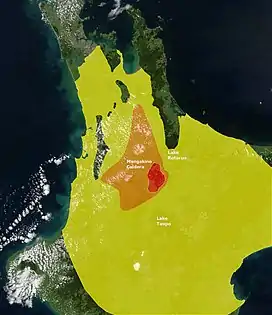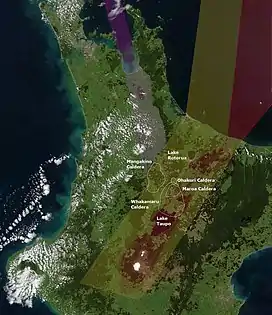Mangakino caldera complex
The Mangakino caldera complex (other names are Mangakino volcanic center, Mangakino Caldera) is the westernmost and one of oldest extinct rhyolitic caldera volcanoes in the Taupō Volcanic Zone of New Zealand's North Island.[4] It produced about a million years ago (1 Ma) in the Kidnappers eruption of 1,200 km3 (287.9 cu mi), the most widespread ignimbrite deposits on Earth being over 45,000 km2 (17,000 sq mi)[1] and was closely followed in time by the smaller 200 km3 (48.0 cu mi) Rocky Hill eruption.[5] The Kidnappers eruption had a estimated VEI of 8 and has been assigned a total eruption volume (not just tephra) of 2,760 km3 (662.2 cu mi). However this was only in its most recent caldera forming phase from 1.21 to 0.91 million years ago as it had a previous caldera generating phase from 1.62 to 1.51 million years ago.[1] There are at least 11 major historic eruptions assigned to this complex.[6] At least 5 of these contributed significant welded ignimbrite deposits that represent major pyroclastic events in the central North Island.[2]
| Mangakino Caldera | |
|---|---|
 Approximate extent of ignambrite sheets from Kidnappers (yellow) and Rocky Hill eruptions (orange) as determined from land drill cores sampling. The Kidnappers ignambrite has been reported in some cores from just beyond the boundaries shown and this map only tries to show where there was full coverage of the then existing landforms and present land surface to convey an idea of the minimal total biosphere disruption.[1][2][3] | |
| Highest point | |
| Coordinates | 38°23′S 175°47′E |
| Dimensions | |
| Length | 30 km (19 mi)[3] |
| Width | 15 km (9.3 mi)[3] |
| Geography | |
 Mangakino Caldera | |
| Geology | |
| Age of rock | |
| Mountain type | Caldera |
| Volcanic arc/belt | Taupo Volcanic Zone |
| Last eruption | 900,000 years ago[3] |

Later many of these deposits were covered over by deposits from other eruptive centres such as those of the Oruanui eruption.
The caldera can be defined by gravitational measurements as 30 km (19 mi) by 15 km (9.3 mi) and its "basement" floor is at least 4 km (2.5 mi) below the present ground surface.[3]
| Formations | layer names | Age range estimate by various methods (if only one method ± error) | Eruptive volume |
|---|---|---|---|
| Marshall | Unit I(Marshall A and B) Ignimbrite Unit H (Kaahu) Ignimbrite Unit G | 0.95 ± 0.03 Ma | |
| Whakaahu | Rhyolite dome | 1.02 ± 0.02 Ma | |
| Raepahu (Potaka Tephra)[1] | Rocky Hill Ignimbrite Kidnappers Unit E Ignimbrite and fall deposit | 0.95 to 1.15 Ma 0.93 to 1.07 Ma | 200 cubic kilometres (48 cu mi) >1,200 cubic kilometres (290 cu mi) |
| Mangaokewa | Ahuroa Ignimbrite Unit D Ignimbrite and fall deposit | 1.16 to 1.33 Ma 1.20 ± 0.04 Ma | |
| Ongatiti | Ongatiti Ignimbrite Tumai Rd dome | 1.16 to 1.34 Ma 1.27 ± 0.05 Ma | >500 cubic kilometres (120 cu mi) |
| Pouakani | Unit C Ignimbrite | 1.68 ± 0.07 Ma (This age inconsistent with position) | |
| Tolley | Unit B Ignimbrite | 1.53 ± 0.04 Ma | |
| Ngaroma | Ngaroma (Unit A) Ignimbrite | 1.31 to 1.6 Ma | |
| Link (source unknown) | Unit F Ignimbrite | 1.60 ± 0.09 Ma |
References
- Cooper, George F; Wilson, Colin; Millet, Marc-Alban; Baker, Joel (2016). "Generation and Rejuvenation of a Supervolcanic Magmatic System: a Case Study from Mangakino Volcanic Centre, New Zealand" (PDF). Journal of Petrology. 57 (6): 1135–1170. doi:10.1093/petrology/egw035.
- Spinks, Karl D. (2005). "Rift Architecture and Caldera Volcanism in the Taupo Volcanic Zone, New Zealand".
- Pittari, Adrian; Prentice, Marlena L.; McLeod, Oliver E.; Zadeh, Elham Yousef; Kamp, Peter J. J.; Danišík, Martin; Vincent, Kirsty A. (2021). "Inception of the modern North Island (New Zealand) volcanic setting: spatio-temporal patterns of volcanism between 3.0 and 0.9 Ma" (PDF). New Zealand Journal of Geology and Geophysics. 64 (2–3): 250–272. doi:10.1080/00288306.2021.1915343.
- Krippner, Stephen J. P.; Briggs, Roger M.; Wilson, Colin J. N.; Cole, James W. (1998). "Petrography and geochemistry of lithic fragments in ignimbrites from the Mangakino Volcanic Centre: implications for the composition of the subvolcanic crust in western Taupo Volcanic Zone, New Zealand". New Zealand Journal of Geology and Geophysics. 41 (2): 187–199. doi:10.1080/00288306.1998.9514803.
- Cooper, G.F.; C. J. Wilson; J. A. Baker; M. Millet (2012). "Rejuvenation and Repeated Eruption of a 1.0 Ma Supervolcanic System at Mangakino Caldera, Taupo Volcanic Zone, New Zealand". AGU Fall Meeting Abstracts. Retrieved 2022-05-15.
- "Mangakino". VOGRIPA. Archived from the original on 9 December 2018. Retrieved 9 December 2018.